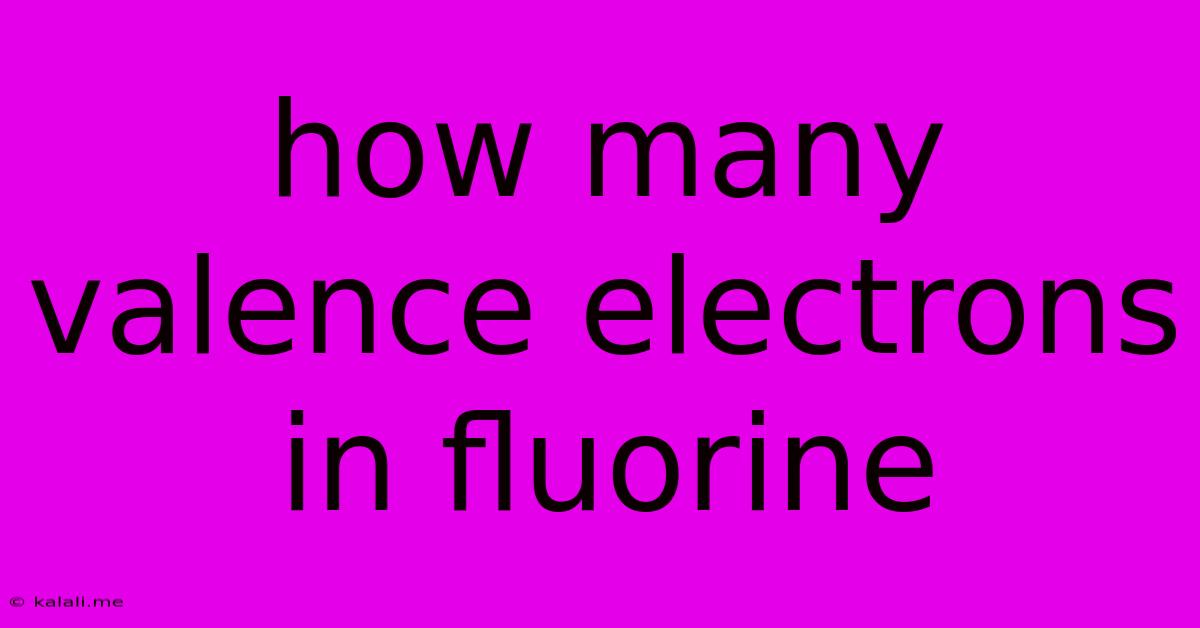How Many Valence Electrons In Fluorine
Kalali
May 09, 2025 · 2 min read

Table of Contents
How Many Valence Electrons Does Fluorine Have? A Deep Dive into Fluorine's Electron Configuration
Fluorine, a highly reactive element known for its pale yellow, diatomic gas form, plays a crucial role in various chemical processes. Understanding its electron configuration is key to grasping its reactivity and bonding behavior. This article will explore the number of valence electrons in fluorine and explain the concept in detail, making it easy for both students and enthusiasts to understand.
What are Valence Electrons?
Before diving into fluorine specifically, let's define valence electrons. These are the electrons located in the outermost shell of an atom. They are the electrons that participate in chemical bonding, determining an element's reactivity and the types of compounds it can form. The number of valence electrons directly influences an element's properties, including its electronegativity and ionization energy.
Fluorine's Electron Configuration and Valence Electrons
Fluorine (F) has an atomic number of 9, meaning it has 9 protons and 9 electrons in a neutral atom. To determine the number of valence electrons, we need to look at its electron configuration. The electron configuration of fluorine is 1s²2s²2p⁵.
- 1s²: This represents two electrons in the first energy level (shell).
- 2s²: This represents two electrons in the second energy level (shell).
- 2p⁵: This represents five electrons in the 2p sublevel of the second energy level.
The outermost shell for fluorine is the second energy level (n=2). Therefore, by adding the electrons in the 2s and 2p sublevels (2 + 5 = 7), we find that fluorine has 7 valence electrons.
Why is this Important? Understanding Fluorine's Reactivity
The fact that fluorine has 7 valence electrons is crucial in explaining its high reactivity. Atoms strive to achieve a stable electron configuration, often resembling that of a noble gas (a full outermost shell). Fluorine, needing only one more electron to achieve a stable octet (8 valence electrons) like neon, readily accepts an electron from other atoms. This high electronegativity makes fluorine a powerful oxidizing agent, readily forming ionic or covalent bonds.
Fluorine's Role in Chemistry and Beyond
This high reactivity makes fluorine essential in various applications:
- Fluorinated compounds: These are prevalent in various industries, from refrigerants to pharmaceuticals, due to their unique properties, such as stability and low reactivity.
- Dental health: Fluoride, the anion of fluorine, strengthens tooth enamel and prevents cavities.
- Industrial applications: Fluorine is used in the production of numerous materials with specialized properties.
Conclusion
In summary, fluorine possesses 7 valence electrons, a characteristic that dictates its exceptional reactivity and its pivotal role in chemistry and various applications. Understanding the electron configuration and the significance of valence electrons is fundamental to comprehending the behavior of this important element. This knowledge provides a solid foundation for further exploration into fluorine chemistry and its impact on various fields.
Latest Posts
Latest Posts
-
How Much Is 2 2 3 Cups
May 09, 2025
-
How Is Fructose Absorbed Facilitated Diffusion
May 09, 2025
-
What Is The Greatest Common Factor For 12 And 18
May 09, 2025
-
What Is The Area Of This Composite Figure
May 09, 2025
-
What Are The Multiples Of 48
May 09, 2025
Related Post
Thank you for visiting our website which covers about How Many Valence Electrons In Fluorine . We hope the information provided has been useful to you. Feel free to contact us if you have any questions or need further assistance. See you next time and don't miss to bookmark.